
Pebble Beach is an unincorporated community on the Monterey Peninsula in Monterey County, California, United States. The small coastal residential community of mostly single-family homes is also notable as a resort destination, and the home of the golf courses of Cypress Point Club, Monterey Peninsula Country Club, and Pebble Beach Golf Links. Nonresidents are charged a toll to use 17-Mile Drive, the main road through Pebble Beach, making it a de-facto gated community.
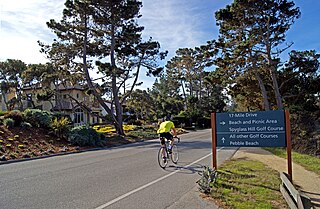
17-Mile Drive is a scenic road through Pebble Beach and Pacific Grove on the Monterey Peninsula in California, much of which hugs the Pacific coastline and passes famous golf courses, mansions and scenic attractions, including the Lone Cypress, Bird Rock and the 5,300-acre Del Monte Forest of Monterey Cypress trees.
Rancho Los Laureles was a 6,625-acre (26.81 km2) Mexican land grant in present-day Monterey County, California given in 1839 by Governor Juan Alvarado to José Manuel Boronda and Vicente Blas Martínez. Los Laureles refers to the California Bay Laurel tree. The grant extended along the Carmel River and the Carmel Valley, was bounded to the east by the Rancho Tularcitos and Rancho Los Laureles (Ransom) on the west, and encompasses present day Carmel Valley Village.
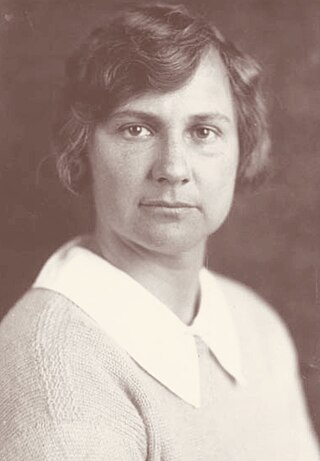
Marion B. Hollins was an American amateur golfer. She is known as an athlete and as a golf course developer, one of the only known female golf course developers in history. She won the 1921 U.S. Women's Amateur and was runner-up in 1913. She also had many other amateur wins. She was the captain of the first U.S. Curtis Cup team in 1932.

The Pacific Improvement Company (PIC) was a large holding company in California and an affiliate of the Southern Pacific Railroad. It was formed in 1878, by the Big Four, who were influential businessmen, philanthropists and railroad tycoons who funded the Central Pacific Railroad, (C.P.R.R.). These men were: Leland Stanford (1824–1893), Collis Potter Huntington (1821–1900), Mark Hopkins (1813–1878), and Charles Crocker (1822–1888). They were controlling stockholders and directors of the company. Archived records date from 1869 to 1931.
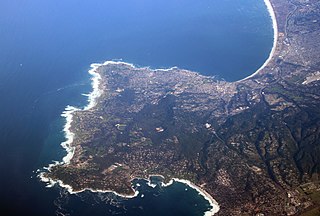
The Monterey Peninsula anchors the northern portion on the Central Coast of California and comprises the cities of Monterey, Carmel, and Pacific Grove, and the resort and community of Pebble Beach.
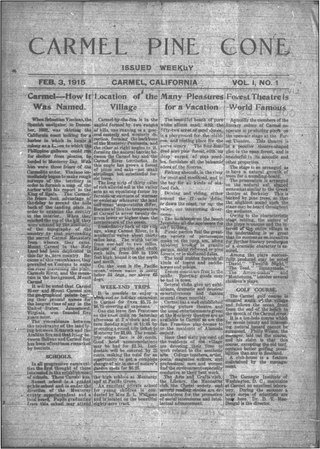
The Carmel Pine Cone is a weekly newspaper serving the city of Carmel-by-the-Sea and the surrounding Monterey Peninsula, Carmel Valley and Big Sur region of Monterey County in central California. Despite not having a digital presence, a PDF of the printed newspaper is available weekly online. The Pine Cone celebrated its centennial edition in February 2015.

The Harrison Memorial Library is a historic building designed by architect Bernard Maybeck and built by Michael J. Murphy in 1928. It houses a public library for the city of Carmel-by-the-Sea, California. The library provides books, materials and programs that support the pursuit of education, information, recreation, and culture. It includes documents about the history and development of Carmel and the Monterey Peninsula. The Harrison Memorial Library was named after California Supreme Court Justice Ralph C. Harrison. It was designated as an important commercial building in the city's Downtown Historic District Property Survey and was recorded with the Department of Parks and Recreation on November 18, 2002.

Thomas Albert Work was an American businessman and banker of Pacific Grove, California, known around Monterey as T. A. Work. He was owner of the T. A. Work company that made him the single largest business property owner on the Monterey Peninsula. He owned several banks, including the First National Bank of Monterey, Bank of Pacific Grove, Salinas, and the Bank of Carmel.

James Franklin Devendorf, was a pioneer real estate developer and philanthropist. Devendorf and attorney Frank Hubbard Powers (1864-1921), founded the Carmel Development Company in 1902. He became the "Father" of an artists and writers' colony that became Carmel-by-the-Sea, California, which included the Carmel Highlands, California. Devendorf spent the next 30 years of his life developing Carmel and the Carmel Highlands into a special community of painters, writers, and musicians.
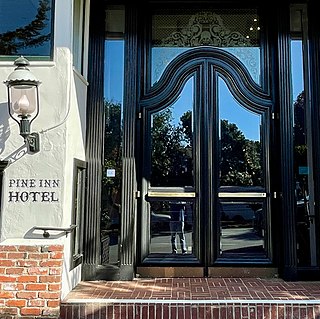
Pine Inn, once called the Hotel Carmelo, is one of the early first-class Arts and Crafts, Tudor, Spanish style hotels established in Carmel-by-the-Sea, California. The Pine Inn is a historical resource dating back to 1889 when pioneer Santiago J. Duckworth built Hotel Carmelo. James Franklin Devendorf, renamed the hotel the "Pine Inn" in 1904. Today, it is a full-service hotel. The Pine Inn qualified for inclusion in the city's Downtown Historic District Property Survey, and was registered with the California Register of Historical Resources on March 18, 2003. The Inn is significant under the California Register criterion 1, as the first hotel in the history of the downtown district of Carmel-by-the-Sea.

El Carmelo Hotel was Pacific Grove's first hotel, opened to guests on May 20, 1887. It was sometimes called the sister of the Hotel Del Monte. It was located on Lighthouse Avenue between Fountain and Grand Avenues, Pacific Grove and owned by the Pacific Improvement Company (PIC). In 1907, the name of the hotel changed to the Pacific Grove Hotel. In 1917, the PIC decided to dismantle it and use the wood in the reconstruction of The Lodge at Pebble Beach, California that had burned down on December 17, 1917. The empty block was sold to W. R. Holman in 1919 to open the Holman Department Store.

The Mary Dummage Shop is a historic Craftsman Fairy tale commercial building in downtown Carmel-by-the-Sea, California. It was built in 1926, by builder Percy Parkes. The shop was designated as a significant commercial building in the city's Downtown Historic District Property Survey, and was recorded with the Department of Parks and Recreation on September 13, 2002. The building is now occupied by the Galante Vineyards Tasting Room.

The Lodge at Pebble Beach is a historic American hotel and clubhouse overlooking the Carmel Bay in Pebble Beach, California. Opened in 1919, the property, operated by Pebble Beach Resorts, is a member of Preferred Hotels & Resorts. Accessed by 17-Mile Drive, the lodge offers views of the Pebble Beach Golf Links.

The Isabel Leidig Building is a historic commercial building in Carmel-by-the-Sea, California. It was built and designed in 1925, by master builder Michael J. Murphy as a restaurant. It is an example of a mix of Monterey colonial style with Spanish Colonial Revival. The structure is recognized as an important commercial building in the city's Downtown Conservation District Historic Property Survey, and was nominated and submitted to the California Register of Historical Resources on June 18, 2002. The building is occupied by Mulligan Public House pub and Gallery North.
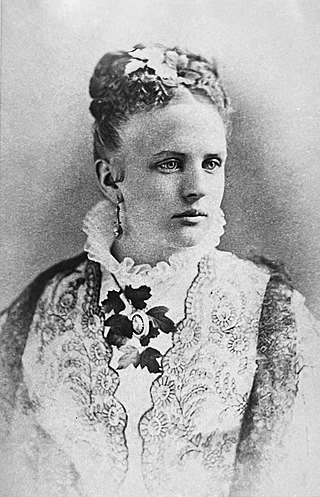
Abigail Jane Hunter, was as an early pioneer businesswoman, real estate developer, and visionary of Carmel-by-the-Sea. In 1889, she worked with Santiago James Duckworth (1862-1930) to help build a Catholic summer resort called Carmel City. After an unsuccessful undertaking, she sold her holdings to Dr. Walton Saunders in 1900. Hunter is credited with coining the name Carmel-by-the-Sea and utilizing it in promoting Carmel City through newspaper advertisements and postcard mailers.

Barnet Joseph Segal was an American businessman and early investor and banker in Carmel-by-the-Sea, California. He helped start several financial institutions, including the Bank of Carmel and the Carmel Savings and Loan Association. He was "historically Carmel's most significant financier." Segal setup the Barnet J. Segal Charitable Trust to distribute his estate for the benefit of Monterey County, California.

Franklin Benjamin Porter, was a pioneer businessman and real estate developer of Monterey Peninsula. In 1926, he launched the first residential subdivision in Carmel Valley, California that became Robles del Rio, California. Porter went on to develop other properties in the valley including the Robles del Rio Lodge, Robles del Rio Carmelo Water Company, and the Hatton Ranch in Carmel Valley.

William Hatton was an American businessman who was one of Carmel Valley, California's pioneers. He was manager of the dairy and cattle interests of the Pacific Improvement Company, acquired land of his own, and became one of the wealthiest dairymen in Monterey County.

Robert R. Jones was an American architect in Carmel-by-the-Sea, California best known for his Modern architecture. He lived in Carmel for more than five decades. Over the course of his career, Jones designed numerous residences and commercial buildings in the Monterey Peninsula. In the post-war period, he emerged as a prominent figure among architects and designers who played a pivotal role in shaping Carmel's modernist landscape from the middle 20th century onward, alongside his fellow local architects. His was known for his design aesthetic that was a Modern architecture-style, combined with elements from the Second Bay Tradition. His design achievements gained global acclaim, notably for the Carmel Valley Inn and expansions to Casa Munras in Monterey. His visionary creation, the Monterey Airport Administration building, earned iconic status in the Modernist movement of that era and was honored with a design award by the Smithsonian Institution.





















